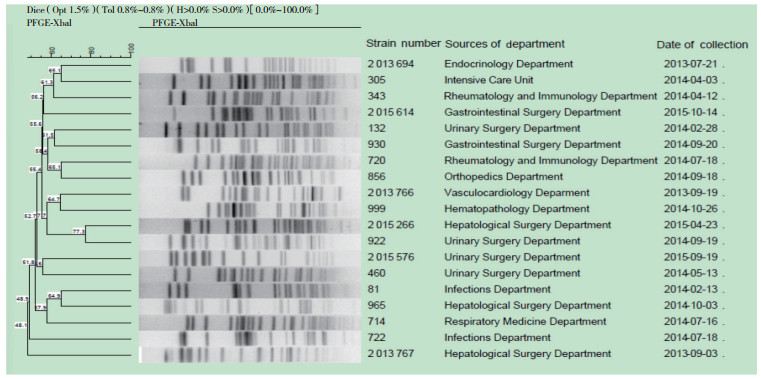文章信息
- 王齐晖, 刘学佳, 胡锦瑞, 褚云卓
- WANG Qihui, LIU Xuejia, HU Jinrui, CHU Yunzhuo
- 肠杆菌科细菌mcr-1基因筛查及其与多黏菌素耐药表型的相关性
- Screening for the mcr-1 Gene in the Members of the Enterobacteriaceae and Its Correlation with Colistin Resistant Phenotype
- 中国医科大学学报, 2018, 47(8): 713-716
- Journal of China Medical University, 2018, 47(8): 713-716
-
文章历史
- 收稿日期:2018-03-13
- 网络出版时间:2018-07-12 11:53
由于产超广谱β-内酰胺酶和碳青霉烯类药物耐药的肠杆菌科细菌所占比例的攀升,多黏菌素被重新应用于治疗肠杆菌科细菌所致的感染,被称为控制多重耐药肠杆菌科细菌感染的最后一道防线。
目前,肠杆菌科细菌对多黏菌素的耐药机制尚未完全了解,2015年我国学者[1]首次在动物家畜和生肉中发现了一种新型质粒携带的多黏菌素耐药基因mcr-1,随着相关研究[2-4]的开展,在欧洲、美洲、非洲也相继发现了该基因的存在。有研究[5]表明mcr-1基因可能为多黏菌素耐药的主要原因。目前国内关于肠杆菌科细菌的mcr-1基因携带情况及其与多黏菌素耐药表型相关性的研究较少,沈阳地区mcr-1基因在肠杆菌科细菌中的携带率尚属未知。另有报道[6]称少数携带mcr-1基因的大肠埃希菌会对多黏菌素敏感,但其发生概率和机制尚不明确。
本研究筛查了2013年至2015年间沈阳地区三甲医院分离的肠杆菌科细菌mcr-1基因的携带情况,利用脉冲场凝胶电泳(pulsed-field gel electrophoresis,PFGE)检测沈阳地区mcr-1基因在肠杆菌科细菌中的流行情况,并通过测定携带mcr-1基因的肠杆菌科细菌对多黏菌素的最小抑菌浓度(minimum inhibitory concentration,MIC),了解和探讨mcr-1基因阳性菌株与多黏菌素耐药表型之间的关系。
1 材料与方法 1.1 材料 1.1.1 菌株来源收集2013年至2015年期间沈阳地区5家三甲医院临床分离的2 680株肠杆菌科细菌(中国医科大学附属第一医院2 210株,中国医科大学附属盛京医院100株,辽宁省中医药大学附属第一医院170株,辽宁省人民医院150株,沈阳医学院附属中心医院50株)。其中,大肠埃希菌1 421株,肺炎克雷伯菌734株,其他肠杆菌科细菌525株。
1.1.2 试剂与仪器PCR相关试剂(日本TaKaRa公司);PCR引物(上海生工生物工程有限公司合成);微量肉汤稀释药敏板(天津金章科技发展有限公司);Seakem Gold agarose (瑞士LONZA公司);PCR仪(GeneAmp PCR System 9700,美国应用生物系统公司);电泳仪和PFGE仪(美国BIO-RAD公司)。
1.2 方法利用生工公司合成的引物(MCR-L-F:5'-GCTCGGTCAGTCCGTTTG-3';MCR-L-R:5'-GAATGCGGTGCGGTCTTT-3')行PCR检测mcr-1基因:预变性94 ℃5 min;;94℃ 1 min,56 ℃ 30 s,72 ℃ 1 min,35个循环;72 ℃延伸10 min。电泳初步确定阳性标本后,产物测序再次确认。
依据2018年新版欧洲抗菌药物敏感性试验委员会(EUCAST)的要求,采用微量肉汤稀释法检测mcr-1携带组及mcr-1基因未携带组菌株的MIC值,采用EUCAST的肠杆菌科细菌对多黏菌素折点的判读标准评价药敏结果。
利用PFGE判断携带mcr-1基因的菌株间有无同源性,PFGE图像用Bio Numertics (Version 5.0)根据条带间的相似性Dice系数,用非加权配对算数平均法(unweighted pair group method using arithmetic,UPGMA)进行聚类分析,判断其流行情况。
应用whonet 5.6软件统计分析细菌的比例,采集科室的分布、样本类型的分布以及药敏结果。
2 结果 2.1 mcr-1基因携带情况(表 1)| Species | Strains number (n) | Strains number of carrying mcr-1(n) | Rate of carrying mcr-1(%) |
| E.coli | 1 421 | 20 | 1.4 |
| Klebsiella pneumoniae | 734 | 6 | 0.8 |
| Enterobacter cloacae | 153 | 0 | 0 |
| Serratia marcescens | 129 | 0 | 0 |
| Enterobacter aerogenes | 60 | 0 | 0 |
| Klebsiella oxytoca | 58 | 0 | 0 |
| Citrobacter freundii | 46 | 0 | 0 |
| Morganella morganii | 31 | 0 | 0 |
| Other species of Enterobacteriaceae | 48 | 0 | 0 |
| Total | 2 680 | 26 | 0.97 |
2 680株菌株中共有26株携带mcr-1基因,其中22株来自中国医科大学附属第一医院,4株来自辽宁中医药大学附属第一医院,其他3家医院没有筛查到携带mcr-1基因的菌株。26株中有20株为大肠埃希菌,6株为肺炎克雷伯菌,其他菌种中没有发现携带mcr-1基因的菌株。
2.2 药敏试验结果18株对多黏菌素耐药(MIC≥4 μg/mL),有7株对多黏菌素的MIC为中介(MIC=2 μg/mL),1株对多黏菌素敏感(MIC≤1 μg/mL)。其中大肠埃希菌对多黏菌素的耐药率为65% (13/20),不敏感率(耐药和中介)为95% (19/20);肺炎克雷伯菌的耐药率为83.3% (5/6),不敏感率为100% (6/6)。随机抽取的52株未携带mcr-1基因的肠杆菌科细菌均对多黏菌素敏感(MIC≤1 μg/mL)。携带mcr-1基因的肠杆菌科细菌对多黏菌素的MIC50、MIC90和MIC range见表 2。
| Species | MIC50 | MIC90 | MIC range |
| E. coli | 4 | 4 | 1-4 |
| Klebsiella pneumoniae | 4 | 8 | 1-8 |
2.3 同源性分析结果
利用PFGE分析中国医科大学附属第一医院临床分离的19株携带mcr-1基因的大肠埃希菌,结果显示条带差异较大,仅有2株聚类相似度接近80%,但时间间隔 > 6个月,其余菌株没有超过66%的聚类,根据Tenover原则,这些菌株之间无同源性,为多克隆菌株(图 1)。

|
| 图 1 脉冲场凝胶电泳结果 Fig.1 Results of PFGE |
3 讨论
mcr-1基因被认为与多黏菌素耐药有直接关系[1]。mcr-1基因目前至少在5种细菌中被发现,包括大肠埃希菌、肠道沙门氏菌、肺炎克雷伯菌、产气肠杆菌以及阴沟肠杆菌,均为肠杆菌科细菌。截止至2016年4月份,mcr-1基因已经至少在18个国家被证实存在[7]。本研究应用特异性引物PCR扩增法从2 680株肠杆菌科细菌中筛选出了26株携带mcr-1基因的菌株,总携带率约为0.97%,其中大肠埃希菌和肺炎克雷伯菌携带mcr-1的比例分别为1.4%和0.8%。这个结果与LIU等[1]对中国人群(广东和浙江)调查得出的mcr-1基因携带率(大肠埃希菌1.4%,肺炎克雷伯菌0.7%)高度一致,说明位于中国东北部的沈阳地区mcr-1基因在肠杆菌科细菌中的携带率与南部地区差异不大。欧洲1项对2014年至2015年间在人群中分离的肠杆菌科细菌mcr-1基因携带率的调查发现其携带率 < 0.1%[8],分析其原因可能是我国畜牧业中大量应用多黏菌素作为兽药,对携带mcr-1基因的肠杆菌科细菌起到了药物筛选作用[7],而根据目前对mcr-1基因的筛选工作来看,从家禽中分离出该基因的比率最高[9],推测国人食用家禽及其内脏比重较高可能是导致我国人群中分离的肠杆菌科细菌携带mcr-1基因的概率远高于欧美国家的重要原因。但目前关于mcr-1基因携带率的研究尚十分有限,还需要日后更大范围、更大样本量的统计研究。
总体来看,本研究结果显示,携带mcr-1基因与多黏菌素耐药是密切相关的,未携带mcr-1基因的大肠埃希菌和肺炎克雷伯菌对多黏菌素均敏感,而26株携带mcr-1基因的菌株中18株对多黏菌素耐药(MIC≥4),有7株对多黏菌素中介敏感(MIC=2)。携带mcr-1基因的大肠埃希菌和肺炎克雷伯菌MIC50和MIC90分别可达到4 μg/mL、4 μg/mL及4 μg/mL、8 μg/mL;携带mcr-1基因的大肠埃希菌和肺炎克雷伯菌对多黏菌素的耐药率分别为65% (13/20)和83.3% (5/6),不敏感率为95% (19/20)和100% (20/20)。理论上mcr-1基因携带株应当都对多黏菌素耐药,但本研究中却发现1株mcr-1基因携带株(MIC≤1)对多黏菌素敏感,这与LIASSINE等[6]2016年报道的携带mcr-1基因的肠杆菌科细菌并不都对多黏菌素耐药的结论相符合。推测可能是该敏感株中存在某种抑制mcr-1基因表达或灭活mcr-1基因编码的磷酸乙醇胺转移酶的机制,具体机制有待于进一步研究。
本研究挑选了分离自中国医科大学附属第一医院的19株携带mcr-1基因的大肠埃希菌进行PFGE,未发现单克隆株,提示目前携带mcr-1的细菌感染是独立、偶发事件,并没有发生院内传播和爆发流行的情况。
尽管目前临床上分离肠杆菌科细菌mcr-1基因携带率并不高,但其已经存在于致病菌群中并在传播中。随着各种抗生素的使用,多重耐药菌群非常可能会同时携带多黏菌素的耐药基因,届时患者将无药可用。多黏菌素近年来已批准应用于临床中,应注意合理用药,避免耐药基因携带菌株的增多甚至暴发流行。
| [1] |
LIU YY, WANG Y, WALSH TR, et al. Emergence of plasmid-mediated colistin resistance mechanism MCR-1 in animals and human beings in China:a microbiological and molecular biological study[J]. Lancet Infect Dis, 2016, 16(2): 161-168. DOI:10.1016/S1473-3099(15)00424-7 |
| [2] |
GRAMI R, MANSOUR W, MEHRI W, et al. Impact of food animal trade on the spread of mcr-1-mediated colistin resistance, Tunisia, July 2015[J]. Euro Surveill, 2016, 21(8): pii=30144. DOI:10.2807/1560-7917.ES.2016.21.8.30144 |
| [3] |
RAPOPORT M, FACCONE D, PASTERAN F, et al. First description of mcr-1-mediated colistin resistance in human infections caused by Escherichia coli in Latin America[J]. Antimicrob Agents Chemother, 2016, 60(7): 4412-4413. DOI:10.1128/AAC.00573-16 |
| [4] |
QUESADA A, UGARTE-RUIZ M, IGLESIAS MR, et al. Detection of plasmid mediated colistin resistance (MCR-1) in Escherichia coli and Salmonella enterica isolated from poultry and swine in Spain[J]. Res Vet Sci, 2016, 105: 134-135. DOI:10.1016/j.rvsc.2016.02.003 |
| [5] |
IRRGANG A, ROSCHANSKI N, TENHAGEN BA, et al. Prevalence of mcr-1 in E.coli from livestock and food in Germany, 2010-2015[J]. PLoS One, 2016, 11(7): e0159863. DOI:10.1371/journal.pone.0159863 |
| [6] |
LIASSINE N, ASSOUVIE L, DESCOMBES MC, et al. Very low prevalence of MCR-1/MCR-2 plasmid-mediated colistin resistance in urinary tract Enterobacteriaceae in Switzerland[J]. Int J Infect Dis, 2016, 51: 4-5. DOI:10.1016/j.ijid.2016.08.008 |
| [7] |
GAO R, HU Y, LI Z, et al. Dissemination and mechanism for the MCR-1 colistin resistance[J]. PLoS Pathog, 2016, 12(11): e1005957. DOI:10.1371/journal.ppat.1005957 |
| [8] |
CASTANHEIRA M, GRIFFIN MA, DESHPANDE LM, et al. Detection of mcr-1 among Escherichia coli clinical isolates collected worldwide as part of the SENTRY Antimicrobial Surveillance Program during 2014-2015[J]. Antimicrob Agents Chemother, 2016, 60(9): 5623-5624. DOI:10.1128/AAC.01267-16 |
| [9] |
PERRIN-GUYOMARD A, BRUNEAU M, HOUEE P, et al. Prevalence of mcr-1 in commensal Escherichia coli from French livestock, 2007 to 2014[J]. Euro Surveill, 2016, 21(6): pii=30135. DOI:10.2807/1560-7917.ES.2016.21.6.30135 |
 2018, Vol. 47
2018, Vol. 47




